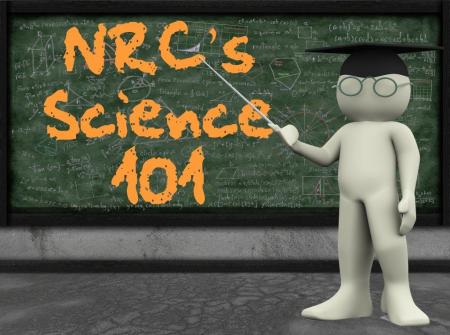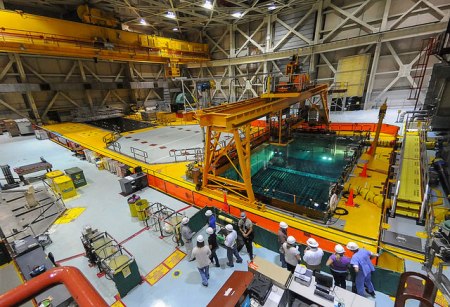NRC Science 101 – About Spent Nuclear Fuel Part II
Posted by on February 26, 2015
Greg Casto
Branch Chief
Division of Reactor Safety Systems
 Our last post
talked about the fuel that powers nuclear reactors. Today, we’ll talk
about what happens to that fuel when it’s removed from a reactor.
Our last post
talked about the fuel that powers nuclear reactors. Today, we’ll talk
about what happens to that fuel when it’s removed from a reactor.
You’ll recall that fuel becomes very hot and very radioactive as it is used in the reactor core to heat water. After about five years, the fuel is no longer useful and is removed. Reactor operators have to manage the heat and radioactivity that remains in the “spent fuel” after it’s taken out of the reactor. In the U.S., every reactor has at least one pool on the plant site where spent fuel is placed for storage. Plant personnel move the spent fuel underwater from the reactor to the pool. Over time, as the spent fuel is stored in the pool, it becomes cooler as the radioactivity decays away.
These pools contain an enormous quantity of water—enough to cover the fuel by about 20 feet. The water serves two purposes: it cools the fuel and shields workers at the plant from radioactivity. Having 20 feet of water above the fuel means there is a lot more water than is needed for cooling and shielding the workers. Also, because of the extra water and the simple design of the pool, there is a lot of time for plant personnel to add water to the pool if needed for any reason.
 The
pools are built to meet strict NRC safety requirements. They have very
thick, steel-reinforced concrete walls and stainless-steel liners, and
are protected by security personnel. There are no drains that would
allow the water level to drop or the pool to become empty. The plants
have a variety of extra water sources and equipment to replenish water
that evaporates over time, or in case there is a leak. Plant personnel
are also trained and prepared to quickly respond to a problem. They keep
their skills sharp by routinely practicing their emergency plans and
procedures.
The
pools are built to meet strict NRC safety requirements. They have very
thick, steel-reinforced concrete walls and stainless-steel liners, and
are protected by security personnel. There are no drains that would
allow the water level to drop or the pool to become empty. The plants
have a variety of extra water sources and equipment to replenish water
that evaporates over time, or in case there is a leak. Plant personnel
are also trained and prepared to quickly respond to a problem. They keep
their skills sharp by routinely practicing their emergency plans and
procedures.
When the plants were designed, the pools were intended to provide temporary onsite storage. The idea was for the spent fuel to sit in the pool for a few years to cool before it would be shipped offsite to be “reprocessed,” or separated so usable portions could be recycled into new fuel. But reprocessing didn’t end up being an option for nuclear power plants and the pools began to fill up.
In the early 1980s, nuclear plants began to look for ways to increase the amount of spent fuel they could store at the plant site. One way was to replace spent fuel storage racks in the pools with racks containing a special material that allowed spent fuel to be packed closer together. Another way was to place older, cooler and less radioactive fuel in dry storage casks that could be stored in specially built facilities at the plant site. We’ll talk more about dry spent fuel storage in future blog posts.
Most plants today use both re-designed storage racks and dry storage facilities to store spent fuel. All storage methods must be reviewed in detail and approved by the NRC before a plant is allowed to change storage methods.
Branch Chief
Division of Reactor Safety Systems
 Our last post
talked about the fuel that powers nuclear reactors. Today, we’ll talk
about what happens to that fuel when it’s removed from a reactor.
Our last post
talked about the fuel that powers nuclear reactors. Today, we’ll talk
about what happens to that fuel when it’s removed from a reactor.You’ll recall that fuel becomes very hot and very radioactive as it is used in the reactor core to heat water. After about five years, the fuel is no longer useful and is removed. Reactor operators have to manage the heat and radioactivity that remains in the “spent fuel” after it’s taken out of the reactor. In the U.S., every reactor has at least one pool on the plant site where spent fuel is placed for storage. Plant personnel move the spent fuel underwater from the reactor to the pool. Over time, as the spent fuel is stored in the pool, it becomes cooler as the radioactivity decays away.
These pools contain an enormous quantity of water—enough to cover the fuel by about 20 feet. The water serves two purposes: it cools the fuel and shields workers at the plant from radioactivity. Having 20 feet of water above the fuel means there is a lot more water than is needed for cooling and shielding the workers. Also, because of the extra water and the simple design of the pool, there is a lot of time for plant personnel to add water to the pool if needed for any reason.
 The
pools are built to meet strict NRC safety requirements. They have very
thick, steel-reinforced concrete walls and stainless-steel liners, and
are protected by security personnel. There are no drains that would
allow the water level to drop or the pool to become empty. The plants
have a variety of extra water sources and equipment to replenish water
that evaporates over time, or in case there is a leak. Plant personnel
are also trained and prepared to quickly respond to a problem. They keep
their skills sharp by routinely practicing their emergency plans and
procedures.
The
pools are built to meet strict NRC safety requirements. They have very
thick, steel-reinforced concrete walls and stainless-steel liners, and
are protected by security personnel. There are no drains that would
allow the water level to drop or the pool to become empty. The plants
have a variety of extra water sources and equipment to replenish water
that evaporates over time, or in case there is a leak. Plant personnel
are also trained and prepared to quickly respond to a problem. They keep
their skills sharp by routinely practicing their emergency plans and
procedures.When the plants were designed, the pools were intended to provide temporary onsite storage. The idea was for the spent fuel to sit in the pool for a few years to cool before it would be shipped offsite to be “reprocessed,” or separated so usable portions could be recycled into new fuel. But reprocessing didn’t end up being an option for nuclear power plants and the pools began to fill up.
In the early 1980s, nuclear plants began to look for ways to increase the amount of spent fuel they could store at the plant site. One way was to replace spent fuel storage racks in the pools with racks containing a special material that allowed spent fuel to be packed closer together. Another way was to place older, cooler and less radioactive fuel in dry storage casks that could be stored in specially built facilities at the plant site. We’ll talk more about dry spent fuel storage in future blog posts.
Most plants today use both re-designed storage racks and dry storage facilities to store spent fuel. All storage methods must be reviewed in detail and approved by the NRC before a plant is allowed to change storage methods.

No comments:
Post a Comment